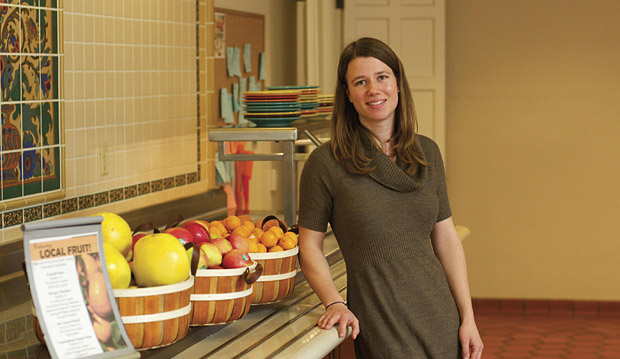Brain Disorders Not for Laughs
Alexander Gelfand’s story, “The Exploding Piano,” about Kathleen Supove ’73 expressed well Supove’s excitement and joy in new music. The energy she brings to her “more inclusive, accessible vision of the piano recital” speaks well to her years of the experimental late ’60s and early ’70s at Pomona. But one recital reported didn’t seem very inclusive.
Although I overlapped her, graduating as a music major in 1969, I don’t remember Kathleen Supove. I suspect neither of us, at that time, would have blanched at “crazy” jokes. But the world is better and
“more inclusive” now. I hope we are both better and kinder now, and that the description of the “show” in Montclair, N.J. where she “came on stage wrapped in a blanket, holding a broom as a pretend rifle, and proceeded to act like a crazy person,” was merely media hyperbole.
One person’s political correctness, is, I suspect, another’s abiding grief. I have a mental illness, but don’t like being called “crazy”; and my daughter, who has schizoaffective disorder, and acts paranoid occasionally, but able to tell a hawk from a handsaw, would not find such an impersonation funny. May we all come to the point where we don’t find “crazy” jokes funny anymore, and where we treat those afflicted with brain disorders with the respect their courage deserves.
—Mary Elgin ’69
Altadena, Calif.
Tower Article Rings Bells
Your article about the Smith Tower carillon (“Old Chimes, New Times”) in the winter issue moves me to make a confession:
An acquaintance was running for freshman class president. A group of his supporters decided to hang a campaign sign atop Smith Tower. I said I could shoot an arrow over the tower, trailing a length of monofilament fishing line. My second shot was true. We started to haul up our nylon rope. Damn! The 6-lb. test line broke. One strand was not enough. We made an eight-strand monofilament hank, capable of supporting more than 47 lbs. The new plan: one strand over the tower with an arrow, then the eight-strand hank, then a rope, then the sign.
In the early hours of Monday, Nov. 13, 1961, we began hauling up our 47-yard long monofilament hank. Oh, no! The wind carried strands into the clock hands, which seemed to reach out and ensnare our makeshift rigging.
Pull! Tug! Yank! Nothing moved except the minute hand, which flexed ominously. Not wanting to leave evidence, we jerked once more. The minute hand suddenly ratcheted from two to six. Time to go!
Worried, we dispersed at 2:47 a.m. Events the next morning confirmed our worst fears. The carillon erupted with seemingly endless chimes. I could see several strands of monofilament wafting from the clock hands, glowing brightly in the fall sunshine. I began to contemplate Life After Expulsion From Pomona.
Agonizing minutes later, I learned the real purpose of the carillon serenade. The previous night, Pomona had vanquished Washington and Lee University on the General Electric College Bowl TV program. Smith Tower was summoning all Sagehens to a rally for the team, which previously had demolished Amherst, Hood, U. of Washington and TCU. With five wins they had retired the huge silver trophy.
A few days later the monofilament disappeared. The clock was reset. I exhaled. The 47-year statute of limitations has expired, so I am now willing to share this story.
—Lew Phelps ’65
Pasadena, Calif.
I enjoyed reading about the ringing of the Smith Tower chimes on the 47th minute of the hour. As a Smiley freshman I walked by the tower countless times on the way to and from Frary, and my friends and I frequently pulled on the heavy metal door in hopes of finding it unlocked. No such luck … until one night, the door moved!
After dinner and under cover of darkness, Jody Wally ’90 and I returned to the tower, sneaked inside and closed the door. It was almost pitch black, but we could make out a narrow, winding staircase attached to the wall, Vertigo-style. Unfortunately, a locked door on the stairs about 8 to10 feet up blocked passage. The only way around it was from the ground, by boosting and pulling each other up through a small opening on the stairs beyond the door. After a successful bypass, we climbed the stairs all the way up, where they ended at a landing underneath a long ladder attached to the wall. The ladder took us up through a hatch and outside to the platform under the bell. The view was fantastic, and it was a thrill to be up there.
We found it curious that conversations and sounds from below sounded much closer than they were.Who knows, maybe ASPC could hold a fundraising raffle for a guided tour of Smith Tower?
—John Kyl ’90
Phoenix, Ariz.
Females in Frary
Regarding “Prometheus Refound” in the winter issue, it will probably come as a shock to you, but I and numerous female cohorts dined with Prometheus in Frary during 1944–45. Clark Hall housed women during World War II and I was one of them. How long women lived in Clark, I am not sure. We had a dorm mother in residence, and Dean of Students Nicholl and Mrs. Nicholl inhabited an upstairs apartment in Clark, too.
I think the winter 2011 issue was really outstanding.
—Patricia Collins Stanley ’46
Fallbrook, Calif.
There’s More to Spanglish
I am writing in response to the letter (winter 2011 issue) from Robert L. Dennis, Jr. ’69 about Spanglish. As a Spanish major, not only have I read Scenes from la Cuenca y otros Natural Disasters, but I have also taken many classes with the author, Professor Susana Chávez-Silverman. Throughout my studies, I have become aware of many different definitions of Spanglish. While Dennis offers one of many older definitions, a more progressive and inclusive one can be found in Paul Allatson’s Key Terms in Latino/a Cultural Identity Studies. Allatson states that Spanglish “designates the many Spanish-English dialects spoken by many millions of Latino/as.” Its meaning in day-to-day practice is in flux, an ongoing discussion. However, it is clear that Spanglish exists on a wide “interlingual spectrum” in which speakers shift back and forth between Spanish dominant and English-dominant grammatical structures and vocabulary. Therefore, Chávez-Silverman’s “foray into Spanglish” is not just a foray, but a political choice that forces members of the mainstream to accept and include what could be called a “hybrid language” into popular culture. Spanglish is not only used by mainly Spanish-speaking people affected by a “combination of dislocation, poverty, and [a] lack of education.” It exists on a wider plane that Chávez-Silverman seeks to make visible. She makes Spanglish acceptable—not something to be ashamed of—which is something remarkable in and of itself.
—Gabrielle Kelenyi ’13
47 Sighting
2011 is a landmark year for our favorite number. It was 47 years ago this summer that two intrepid mathematical pioneers, about to begin their first year at Pomona, set out to prove—with tongue in cheek— that 47 shows up randomly in nature more often than any other number. Since that time, 47 has taken hold of the collective imagination of Sagehens. This semester, the College celebrated the 47th anniversary of 47 with birthday cake, giveaways, general hoopla and a 47-second video tribute that
you can see online at vimeo.com/pomonacollege/47.
 While visitors hung out and played old records from the station’s still-extensive collection, Tyron noted that some students find working with LPs a tad intimidating because of the direct contact with the surface of the record: “People just get nervous that you’re going to break something.”
While visitors hung out and played old records from the station’s still-extensive collection, Tyron noted that some students find working with LPs a tad intimidating because of the direct contact with the surface of the record: “People just get nervous that you’re going to break something.”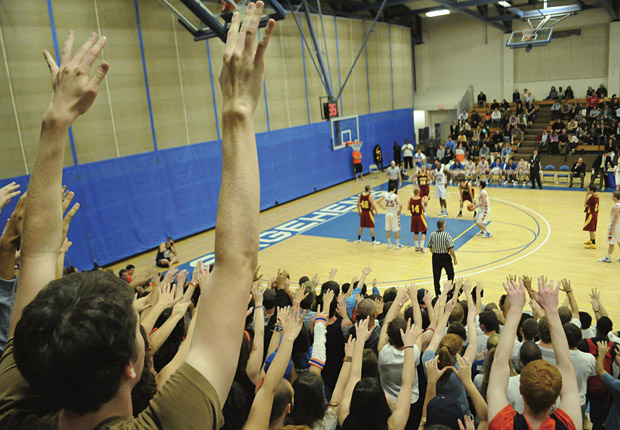
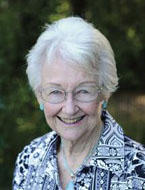
 As a boy growing up in Chicago, Laurence Pommells ’11 begged his mother for a year before she agreed to sign him up for martial arts lessons. Looking back, he doesn’t begrudge her. She just wanted to make sure he would stick with it.
As a boy growing up in Chicago, Laurence Pommells ’11 begged his mother for a year before she agreed to sign him up for martial arts lessons. Looking back, he doesn’t begrudge her. She just wanted to make sure he would stick with it.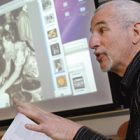
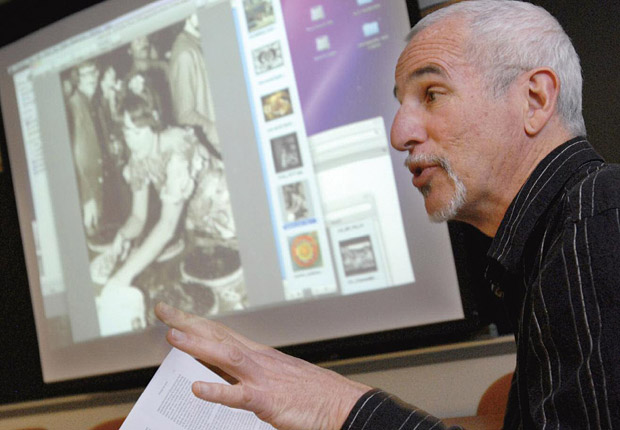 For tonight’s meeting of Professor Victor Silverman’s seminar class on California history, students were assigned to read architecture critic Reyner Banham’s influential 1971 book Los Angeles: The Architecture of Four Ecologies. An unabashed fan of L.A., the chipper British academic viewed the city through distinct “ecologies”:
For tonight’s meeting of Professor Victor Silverman’s seminar class on California history, students were assigned to read architecture critic Reyner Banham’s influential 1971 book Los Angeles: The Architecture of Four Ecologies. An unabashed fan of L.A., the chipper British academic viewed the city through distinct “ecologies”:
